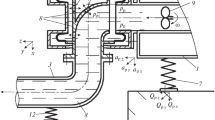The results of experimental and computational studies to identify the reasons for the increase in the vibration transmission through compensators of pipelines with liquid by several orders of magnitude with increasing frequency are considered. The descriptions of the found physical and computational models of this phenomenon are given. The results of experimental studies carried out on a special stand to study the possibility of reducing this transmission in a wide range of oscillation frequencies from 10 to 300 Hz by an order of magnitude or more by means of passive and active vibration damping methods are given. It has been shown experimentally that in the case of active spatial damping of dynamic forces behind the compensator, the mutual influence of the damping channels can significantly change the efficiency of the system.
Similar content being viewed by others
References
A. V. Kiryukhin, O. O. Milman, and A. V. Ptakhin, “Reducing the vibration transmission from power plants by active methods,” Teploénergetika, No. 12, 58 – 66 (2017).
R. F. Ganiev, Nonlinear Resonances and Catastrophes. Reliability, Safety, Noiselessness [in Russian], Dinamika, Moscow (2013).
R. F. Ganiev, Kh. N. Nizamov, A. I. Chucherov, and P. P. Usov, Stabilization of Pressure Pulsations in Pipeline Systems of Power Plants [in Russian], Izd. MGTU, Moscow (1993).
G. N. Kuznetsov, A. V. Kiryukhin, V. A. Fedorov, E. S. Belogubtsev, S. G. Mikhailov, A. A. Pudovkin, and D. A. Smagin, “Testing of low frequency water and air signal active cancellation techniques: problems and preliminary results,” Fundam. Priklad. Gidrofiz., 4(3), 93 – 107 (2011).
A. V. Kiryukhin, V. A. Tikhonov, A. G. Chistyakov, and V. V. Yablonsky, “Active vibration: protection, purpose, principles, state. 5. Active vibration and noise isolation of pipelines. Patent research,” Probl. Mashinostr. Avtomatiz., No. 3, 125 – 131 (2013).
S. M. Khot, N. P. Yelve, R. Tomar, S. Desai, and S. Vittal, “Active vibration control of cantilever beam by using PID based output feedback controller,” J. Vib. Control, 18(3), 366 – 372 (2012).
E. Omidi and N. Mahmoodi, “Vibration suppression of distributed parameter flexible structures by Integral Consensus Control,” J. Sound Vib., 364, 1 – 13 (2016).
V. I. Popkov and S. V. Popkov, Oscillations of Mechanisms and Structures [in Russian], Sudarynya, St. Petersburg (2009).
A. V. Kiryukhin, O. O. Milman, and A. V. Ptakhin, “A search for the physical principles of improving the power unit pipeline expansion joint with fluid vibro-isolating properties,” Int. J. Appl. Eng. Res., 11(23), 11176 – 11183 (2016).
A. V. Kiryukhin, O. O. Milman, A. V. Ptakhin, L. N. Serezhkin, and A. V. Kondratev, “Development and calculation-experimental analysis of pressure pulsations and dynamic forces occurrence models in the expansion joints of pipelines with fluid,” Int. J. Appl. Eng. Res., 12(19), 8209 – 8216 (2017).
A. V. Kiryukhin, O. O. Milman, and A. V. Ptakhin, “The influence of the transverse sensitivities of vibration force sensors on the efficiency of an active vibration protection system,” Int. J. Emerg. Tren. Eng. Res., 8(1), 203 – 207 (2020).
Author information
Authors and Affiliations
Corresponding author
Additional information
The study was carried out on the basis of agreement No. 16-19–10292 dated 05.12.2016 between the Russian Science Foundation and Kaluga State University named after K. E. Tsiolkovsky on the grant for fundamental scientific research and exploratory scientific research on the scientific project “Research of methods and means of reducing the vibration transmission and pressure pulsations from power plants through elastic vibration isolations of pipelines with liquid by suppressing vibration forces and pulsations of the medium by active damping systems”.
Translated from Élektricheskie Stantsii, No. 7, July 2020, pp. 41 – 48.
Rights and permissions
About this article
Cite this article
Kiryukhin, A.V., Mil’man, O.O., Serezhkin, L.N. et al. Vibration Transmission Through Compensators of Power Plants Pipelines and Methods for Its Reduction1. Power Technol Eng 54, 707–713 (2021). https://doi.org/10.1007/s10749-020-01274-z
Published:
Issue Date:
DOI: https://doi.org/10.1007/s10749-020-01274-z




